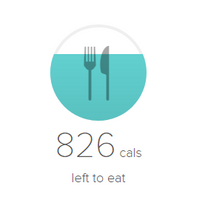Join us on the Community Forums!
-
Community Guidelines
The Fitbit Community is a gathering place for real people who wish to exchange ideas, solutions, tips, techniques, and insight about the Fitbit products and services they love. By joining our Community, you agree to uphold these guidelines, so please take a moment to look them over. -
Learn the Basics
Check out our Frequently Asked Questions page for information on Community features, and tips to make the most of your time here. -
Join the Community!
Join an existing conversation, or start a new thread to ask your question. Creating your account is completely free, and takes about a minute.
Not finding your answer on the Community Forums?
- Mark Topic as New
- Mark Topic as Read
- Float this Topic for Current User
- Bookmark
- Subscribe
- Mute
- Printer Friendly Page
How do Caloric Budgets work in the Fitbit app?
- Mark Topic as New
- Mark Topic as Read
- Float this Topic for Current User
- Bookmark
- Subscribe
- Mute
- Printer Friendly Page
04-29-2019
11:56
- last edited on
04-30-2019
09:32
by
MarcoGFitbit
![]()
- Mark as New
- Bookmark
- Subscribe
- Permalink
- Report this post
04-29-2019
11:56
- last edited on
04-30-2019
09:32
by
MarcoGFitbit
![]()
- Mark as New
- Bookmark
- Subscribe
- Permalink
- Report this post
Hey all,
A brief summary of my weight loss journey, I am 27 and 5'11, when I was 25 I lost 30 pounds in a few months by doing 45mins-1hr of cardio a day plus intense starvation. Together with weightlifting, I was in the best shape of my life with hardly any fat on me. I don't know how I was able to do this without collapsing, but I had no energy and lost a ton of hair density.
Fast forward two years later, my weight has gone up and down to 188. On march 30 I started counting calories at what I THOUGHT was a 1,000-500 calorie deficit daily, and running 2 miles a day plus around 2-3 of walking. I weight myself today (a month later) and I am still 188.
Now, I was starting to get frustrated thinking I hadn't been losing any weight because I just can't, until I was fidgeting with the settings and found where I include how many pounds per week I want to lose. I set it to 2 pounds a week.
This is what tickles my fanny about the app:
Before changing the settings, my remaining budget after running+walking 5 miles at 11:am, was at 2,400 with 350ish in.
After adjusting the settings, my remaining budget when down to 1,400.
This means, every day when I thought I was in a 500-1,000 calorie deficit, I was actually either breaking even or in a SURPLUS what the hell. How did it come up with the original number? What didnt change was my goal weight! I had already included that. So what the faq????
Moderator Edit: Clarified Subject.
 Best Answer
Best Answer04-29-2019 12:50
- Mark as New
- Bookmark
- Subscribe
- Permalink
- Report this post
 Fitbit Product Experts Alumni are retired members of the Fitbit Product Expert Program. Learn more
Fitbit Product Experts Alumni are retired members of the Fitbit Product Expert Program. Learn more
04-29-2019 12:50
- Mark as New
- Bookmark
- Subscribe
- Permalink
- Report this post
@xxoe My guess is that when you did not put in a calorie deficit goal it just assumed you wanted to stay the weight you were even though you had a target weight that was lower than your current weight.
Be careful with the remaining calorie intake estimates from Fitbit. They give you two numbers. One is the above or below goal number. That one is a 'real time' estimate that takes your daily deficit goal and assumes a linear path from midnight to midnight. If your deficit goal is 1000 calories per day, it would look to see if your intake and expenditure at noon is 500 calories. Since you won't normally consume calories in a linear rate this number can swing wildly throughout the day.
The second number is the calories remaining to consume. Fitbit estimates your expenditure for the rest of the day based on your history. This tends to be relatively accurate unless you change up your normal routine so just keep that in mind when you see this number.

Warren | Cincinnati, OH
Versa Lite, Ionic, Charge3, Inspire HR, Blaze(retired), Alta( retired),- Pixel 3
Take a look at the Fitbit help site for further assistance and information.
 Best Answer
Best Answer04-30-2019 09:39
- Mark as New
- Bookmark
- Subscribe
- Permalink
- Report this post
 Community Moderator Alumni are previous members of the Moderation Team, which ensures conversations are friendly, factual, and on-topic. Moderators are here to answer questions, escalate bugs, and make sure your voice is heard by the larger Fitbit team. Learn more
Community Moderator Alumni are previous members of the Moderation Team, which ensures conversations are friendly, factual, and on-topic. Moderators are here to answer questions, escalate bugs, and make sure your voice is heard by the larger Fitbit team. Learn more
04-30-2019 09:39
- Mark as New
- Bookmark
- Subscribe
- Permalink
- Report this post
Hello @xxoe thanks for joining the Fitbit Community, it's great to have you on board. It's nice to see you too @wtksk8r thanks for all your help.
@xxoe thanks for your participation in the Forums and for sharing your experience with us. Adding to what @wtksk8r mentioned, note that when you start a food plan, depending on the aggressiveness of the plan you will only be allowed to consume a determined amount of calories, if you consume more calories than allowed you will be able to see these calories were "over" your total. Please note that the Daily Calorie Estimate uses your average activity to give you an estimate of how many calories you should eat for the whole day to meet your weight goal. This updates throughout the day if you are more or less active than usual. As you log food during the day, the calories you can still eat will update, you will be in your goal zone as long as you are within 50 calories of your deficit goal for the current time of day.

The Daily Calorie Estimate is an estimate of the total calories you can eat for the whole day, taking your BMR, Activity Calories, Food Plan deficit, and whether you're on a Personalized or Sedentary plan into account. The Calories In vs Out gauge, on the other hand, is specific to the current time of day, and includes the fraction of your food plan deficit that you should have earned by that time of day as well as the calories you've actually burned in the same time period. If you think of the Calories In vs Out gauge as an "Eatometer," showing how fast you're consuming your daily calories, it may make understanding the difference easier.

The Calories In vs Out gauge, however, only gives credit for calories actually burned so far for the day. At 6AM, they may have burned only a few hundred calories BMR while sleeping, plus a few activity calories for stumbling to the bathroom, brushing their teeth, and making their way to the breakfast table. In addition, since it's 6AM, 25% of the day is gone, which means that the gauge needs to hold 25% of their daily deficit in reserve. If they're on the 500-calorie deficit plan, that's another 125 calories to be accounted for. So it's quite reasonable for the Daily Calorie Estimate to show 300 calories left to eat for the day, while the "Eatometer" is WAY over in the red zone, shouting "Slow Down, you're eating too fast!" Early in the day, that's not a problem; later in the day, you should be paying close attention.
To summarize, the Daily Calorie Estimate will often tell you that you have more calories available to eat, even if you're "over budget" at the current time. It's okay to be "over budget" early in the day, since it's better to eat earlier rather than later, but be careful about running over the Daily Calorie Estimate for the day unless you have a lot more exercise planned.
Also remember that the Daily Calorie Estimate will increase throughout the day as activities burn calories, so that 1300 morning estimate may turn into 2500 or more by the end of the day. Don't assume that the first number you see in the morning is your final daily food budget, unless you're planning to lay in bed all day.
With that said, if there's anything else we can do for you, please feel free to reply, we'll be happy to help.
 Best Answer
Best Answer